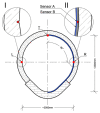Monitoring of Large Diameter Sewage Collector Strengthened with Glass-Fiber Reinforced Plastic (GRP) Panels by Means of Distributed Fiber Optic Sensors (DFOS)
- PMID: 34640927
- PMCID: PMC8512076
- DOI: 10.3390/s21196607
Monitoring of Large Diameter Sewage Collector Strengthened with Glass-Fiber Reinforced Plastic (GRP) Panels by Means of Distributed Fiber Optic Sensors (DFOS)
Abstract
Diagnostics and assessment of the structural performance of collectors and tunnels require multi-criteria as well as comprehensive analyses for improving the safety based on acquired measurement data. This paper presents the basic goals for a structural health monitoring system designed based on distributed fiber optic sensors (DFOS). The issue of selecting appropriate sensors enabling correct strain transfer is discussed hereafter, indicating both limitations of layered cables and advantages of sensors with monolithic cross-section design in terms of reliable measurements. The sensor's design determines the operation of the entire monitoring system and the usefulness of the acquired data for the engineering interpretation. The measurements and results obtained due to monolithic DFOS sensors are described hereafter on the example of real engineering structure-the Burakowski concrete collector in Warsaw during its strengthening with glass-fiber reinforced plastic (GRP) panels.
Keywords: collector; concrete; cracks; displacements; distributed fiber optic sensing DFOS; glass fiber reinforced polymer GFRP; layered cables; monolithic sensors; strains; strengthening; tunnels.
Conflict of interest statement
The authors declare no conflict of interest.
Figures
















References
-
- Gerbrandt J.L., Westman C.N. When a pipe breaks: Monitoring an emergency spill in the oil sands and documenting its erasure of indigenous interests in land. Extr. Ind. Soc. 2020;7:1301–1308. doi: 10.1016/j.exis.2020.07.012. - DOI
-
- Bednarz B. Numerical verification o the thickness of GRP Panels for modernization of large-diameter sewage collectors with non-circular cross-sections. In: Skoczko I., Krawczyk D.A., Szatyłowicz E., editors. Series of Monographs Vol. 38 Innovations, Sustainability, Modernity, Opennes—Water. Volume 38. Faculty of Civil and Enviromenal Engineering Białystok University of Technology; Bałystok, Poland: 2019. pp. 77–87.
-
- Nienartowicz B. Underground Infrastructure of Urban Areas 3. CRC Press; Leiden, The Netherlands: Balkema, Cop.; Avereest, The Netherlands: 2014. Analysis of selected aspects of the operation of pipelines renewed with the relining method on the basis of laboratory testing results; pp. 181–189.
MeSH terms
Substances
LinkOut - more resources
Full Text Sources
Miscellaneous

